DIY septic tank installation: installation and maintenance instructions
The task of creating an autonomous sewage system in a suburban area can be handled independently without any problems. A wide range of designs are produced for the organization of its storage and treatment facilities. They need to be correctly installed in the pit and connected to the sewer pipeline.
However, for the normal operation of the system, it is necessary that it be built in strict accordance with the installation requirements. As an illustrative example, we will analyze how to install a septic tank. This is a typical sewage treatment plant for non-volatile sewage.
You will learn all about choosing an appropriate capacity tank and installation rules for a treatment plant from our article. We set out in the finest details the steps for assembling and installing a septic tank. Based on our recommendations, you can build a fail-safe system.
The content of the article:
Device and principle of operation
Traditionally, in the private sector, a drainage well or pit without a bottom is arranged. However, such a method with a modern standard of living with frequent use of chemical detergents is unacceptable. The ecosystem of the site and the whole district suffers. An unpleasant smell is a common drawback of such a structure.
Installing a sealed storage tank will help only with periodic residence. Otherwise, the costs of the services of a cesspool worker, especially if there is a shower and a washing machine in the house, become significant.
Septic tank is a local structure, which is dug into the ground in its own area. In fact, this is an underground tank-settler, in which mechanical and then biological treatment of sewage occurs first.
After the septic tank, the degree of water purification reaches 75%, so you should definitely install an additional after-treatment device - a filtration field, an infiltrator, a filter well
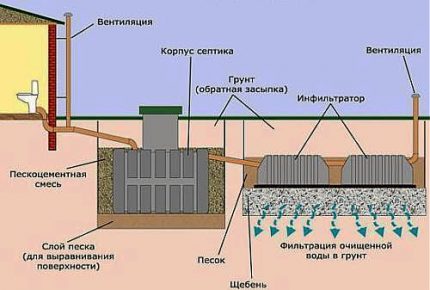
Septic Tank is a molded container made of polypropylene, the internal volume of which is divided into three sections. The cameras are interconnected by internal overflows, the latter is equipped with a powerful eco-filter system.
The case of the device is lightweight and at the same time durable. Thick, elastic, ribbed walls withstand the pressure of the soil, while not being deformed. In the upper part there are service hatches. The design of the tank is modular, which allows you to gain any required amount of water drainage by connecting several devices in series.
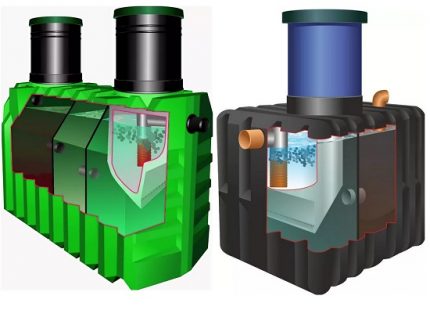
Each septic tank performs a specific task. The first is the reception room - all drains from the house get into it and undergo primary treatment. As a result of sedimentation, heavy particles sink to the bottom and form a sludge layer, and light fat and organic fractions float up.
Conventionally clean water from the middle region gets into the next section. Here the process is similar - retaking takes place.
In the last chamber, the liquid passes through a floating module - a filter made of polymer fibers, in which colonies of anaerobic bacteria settle. Under their influence, decomposition of waste occurs, the remains of the process settle on the bottom.
The manufacturer recommends cleaning the septic tank from sludge once a year.
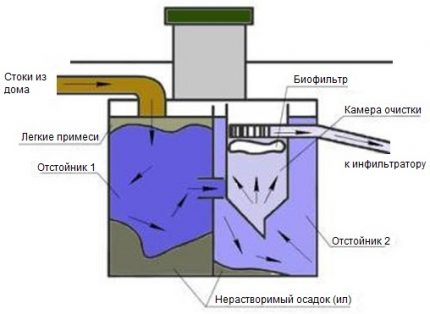
For complete water purification, the system must be supplemented with a soil after-treatment device. Since the installation of the Tank septic tank is most often done with your own hands, the most convenient facilities are industrial-made infiltrators. They allow you to organize a wastewater treatment system in the shortest possible lines and do not require complicated installation.
Structurally, the infiltrator is an elongated reservoir with ribbed strong walls and without a bottom. Outwardly, it resembles a cover. From the ends there are nozzles - inlet and outlet.
The output is used to connect several modules in series or to output a ventilation pipe. There are models without an outlet pipe - they have a ventilation hole in the upper part of the case.

The filtering layer is a cushion of sand and gravel or gravel on which the device body is mounted. Passing through such a cleaning natural filter, all undecomposed impurities and substances remaining in the water settle and water gets into the ground, comparable in purity to technical.
Advantages and disadvantages of septic tanks Tank
Among the owners of houses in cottage and holiday villages Septic Tank are in constant demand due to its advantages:
- Strong and reliable monolithic design;
- The ability at any time to increase the performance of the cleaning system by adding an additional septic tank and infiltrators to the circuit (thanks to the block-modular device);
- High efficiency of wastewater treatment in combination with infiltrators;
- Long service life;
- The septic tank operates autonomously, without any energy sources;
- The small size of the containers and their light weight allow you to do it yourself;
- Low labor costs during installation;
- No need for frequent maintenance - just use the services of a scavenger once a year and pump out sludge;
- Affordable cost - septic tanks belong to the average price category among similar products on the market.
The high-quality plastic of which the container is made is not susceptible to corrosion and erosion under the influence of aggressive inclusions in soils, erosion by water and cracking. It is steady against aggressive influence of waste masses. Therefore, a sewer system with such a septic tank has a long service life of at least 50 years.
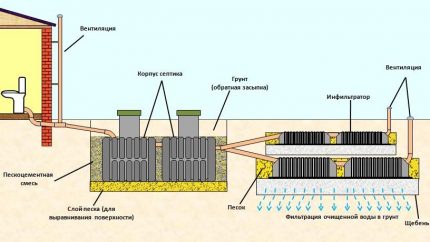
Tank tanks also have disadvantages:
- Mandatory after-treatment of the liquid leaving the septic tank is necessary;
- Improper installation and operation lead to an unpleasant odor from the sewer;
- With close proximity to groundwater, additional drainage systems are required.
It is necessary to consider the location of groundwater throughout the year. Spring floods can become a serious annual problem, when the filter layer of the infiltrator will simply be filled with liquid and will threaten an excessive increase in groundwater level.
If the site area allows, it is better to arrange for the disposal of settled and clarified water filter field. This option will allow the discharge of the processed liquid component of the effluent into the upper layers of the geological section. They usually absorb water quickly because differ in high filtration properties.
Therefore, in areas with a characteristic seasonal occurrence of flood waters, an elementary drainage well with a submersible pump for pumping out excess fluid and dumping it onto the terrain (into the drainage ditch).
How to choose the right model?
When choosing the elements of a sewage treatment system, the number of people permanently living in the house becomes a determining factor. For each tenant, according to the standards, 200 liters per day is required. Therefore, the minimum productivity of a septic tank for a small family of three is 600 liters per day.
In combination with septic tanks Tank use Triton-400 infiltrators. Their number is also selected taking into account the daily flow of water. Soil absorbency is also taken into account - for clay representatives, the number of hulls is doubled.
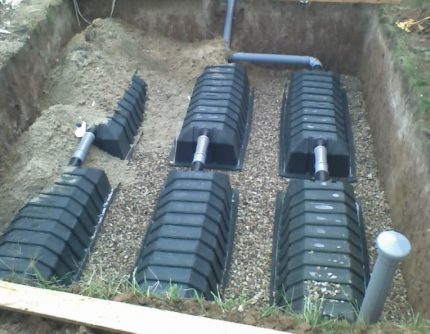
Septic Tanks are available in different versions, each of which is equipped with manufacturer's recommendations:
- Tank 1 - suitable for serving three permanent residents and a daily waste water volume of up to 600 liters. It has overall dimensions of 1.2 mx 1 mx 1.7 m, weight - 75 kg. One infiltrator is mounted in a chain with it when installed on peat and sand deposits and two on clay soils.
- Tank 2 - Handles up to 800 liters of effluent per day, able to serve up to four people. Dimensions - 1.8 m × 1.2 m × 1.7 m, installation weight - 130 kg. Two infiltrators go to it, four are installed on clay rocks.
- Tank 2.5 - daily output is one thousand liters, dimensions - 2 m × 1.2 m × 1.85 m. Suitable for four to five people. Weight - 140 kg. The number of infiltrators is similar to the installation of Tank 2.
- Tank 3 - a septic tank provides drainage in the amount of 1200 liters, serving five to six family members. Unit weight - 150 kg, dimensions - 2.2 m × 1.2 m × 2 m. In areas with peat and sandy soils, three infiltrators are connected to it, and six on sandy loams and loams.
- Tank 4 - Set up to nine permanent residents for wastewater from one or several buildings and services.Productivity - up to 1800 liters per day. The weight of the septic tank is 230 kg, overall dimensions - 3.6 m × 1 m × 1.7 m. Together with it, four infiltrators are installed in the sand and peat, eight - on clay and loam.
If the amount of effluent will constantly exceed the recommended one, then insufficiently purified water will merge into the soil and the ecosystem of the site may suffer.
Too much septic tank will not be economical and will require more space. Choosing a tank with greater productivity is worth it if the house is often hosting guests or planning to replenish the number of residents.
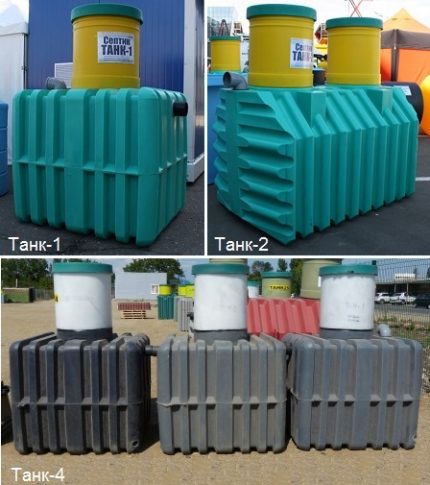
Step-by-step installation instructions
Installation of elements of an autonomous cleaning system is simple. However, it has its own subtleties, so before starting work, you must carefully study the installation instructions for the tank septic tank, infiltrators, sewer pipelines and strictly follow the technology.
Stages of work include preparatory, earthwork, directly installation, connection and backfilling.
Step # 1 - preparatory work
To avoid problems during operation, it is necessary to thoroughly approach the preparation of the place, the necessary materials, tools and structural elements.
First of all, choose the installation location. Any modern septic tank is a sealed and durable design. Nevertheless, the cleaning system poses a certain environmental threat, since the possibility of pipe rupture or depressurization of the joints cannot be ruled out.
Therefore, accommodation is planned taking into account sanitary standards:
- Sewerage elements are removed from the water intake point to a distance of 20-50 m (depending on the type of soil), from the water supply to 10 m to eliminate the potential for contamination of the source of drinking water;
- The minimum distance to the house is 5 m, so that the water filtered and absorbed into the soil layers does not wash out the foundation, the maximum is 15 m, otherwise it will be difficult to observe the slope necessary for the gravity flow of drains;
- Free passage to the installation site of the tank should be provided, since the septic tank must be cleaned;
- It is forbidden to install treatment facilities close to the boundary of the site - the minimum distance from the neighbor’s fence should be 2 m, from the public road with heavy traffic - 5 m, from the passage - 2 m;
- Distance from the gas pipeline - at least 5 m;
- It is impossible to mount treatment products near plants with a strong root system - the distance from trees should not be less than 3 m, from shrubs - 1 m.
Based on these rules, the site is marked up for the location of all the elements of the treatment system, they plan the laying of the trunk from the house.
It is advisable to mount the pipeline in a straight line - blockages form at the turning points. If you can not do without them, then at the points of change of direction equip inspection (inspection) wellsto allow cleaning.
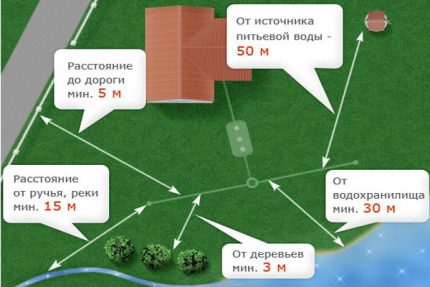
The depth of groundwater and the type of sedimentary rocks in the area are determined. The depth of the pits, the number of infiltrators and the need to equip additional drainage elements will depend on this.
Prepare the necessary materials. To install a septic tank you will need:
- coarse sand;
- cement;
- gravel (crushed stone);
- geotextiles;
- plastic construction mesh;
- insulation.
With high groundwater, it is necessary to exclude the possibility of pushing the tank to the surface. To do this, prepare a concrete slab, or concrete mortar, to pour it in place.
Step # 2 - excavation and excavation
Prepare a foundation pit under a septic tank. Its width and length must exceed the corresponding overall dimensions of the tank by 25-30 cm.
The depth is calculated taking into account the height of the tank, the thickness of the sand cushion, the presence of concrete screed and ensuring the necessary slope of the sewer pipeline. The deepening of the upper wall of the body relative to the level of the day surface should not exceed 1 m, but at the same time be sufficient for effective insulation of the tank.
At the bottom of the pit, sand is poured with a layer of 30-40 cm and compacted tightly. To separate the soil of natural occurrence and a loose sand cushion, a geo-fabric is laid.
If the groundwater level is low, then this is enough. Otherwise, it is required to lay a reinforced concrete slab on top of the sand cushion, or make a concrete screed.
In the concrete slab (screed), metal loops must be laid, the distance between which is greater than the dimensions of the case. If there are no loops, you can install anchor eyebolts.
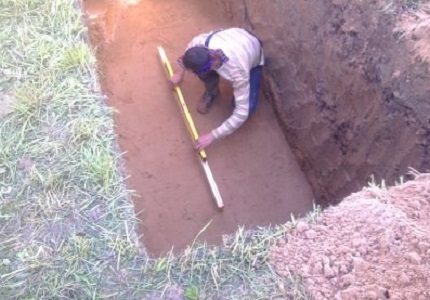
Next, you need to dig a pit for infiltrators. The minimum distance from it to the pit for a septic tank is 2 m. The distance from the side walls of the pit to the walls of the device is 50 cm. The dimensions of the pit depend on the number of installed infiltrators.
The walls of the prepared pit are covered with geotextile, a building plastic mesh is laid at the bottom, and 40 cm of a mixture of gravel (crushed stone) and coarse sand are laid on it.
Under the pipeline, trenches are arranged from the house to the septic tank and from the septic tank to the infiltrator. Their width should exceed the diameter of the sewer by 40 cm (20 on each side). Their bottom is also covered with sand - 10-20 cm thick, it should not be densified strongly.
Step # 3 - installing infiltrators
It is better to install the tank with the help of a crane, as the septic tank will need to be installed without displacements and distortions, exactly in the center of the prepared foundation pit.Lighter models can be gently lowered using ropes or cloth panels - for this you will need to bring at least three helpers to work.
Proper drainage and the shape of the tank exclude its ascent under the influence of groundwater. However, in areas with characteristic sharp soil flooding (seasonal, as a result of river spills or after heavy rains), it is recommended to anchor the septic tank.
To do this, bandage belts are thrown over the upper surface of the case and securely fasten them in the hinges of the metal embedded reinforcement.
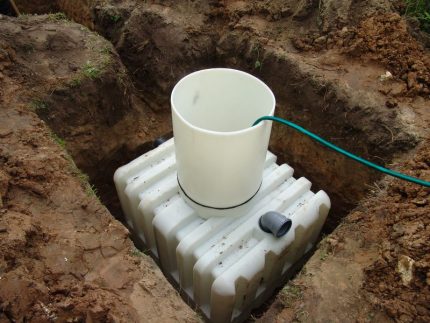
In the pit prepared for the infiltrators, they put the necessary number of devices. A ventilation riser is mounted on the last in the chain housing.
Step # 4 - connecting elements to the sewer of the house
Lay a pipeline from the sewer outlet pipe from the house to the septic tank and from the septic tank to the infiltrators. Lay pipes with a slope, ensuring spontaneous movement of effluents to the treatment point.
For connection it is recommended to use rubber connecting cuffs so that the connections are tight, but not rigid. This will protect the plastic sewer pipes from the appearance of cracks and destruction during seasonal displacements of the soil layers.
Sewer line must have a bias from home to the last element of the system. Its optimal value for a pipeline with a diameter of 110 mm is 2 cm per linear meter. In this case, a smooth and silent drainage of wastewater is guaranteed and the accumulation of solid fractions and the formation of blockages are virtually eliminated.

On the section of the highway leading to the septic tank, be sure to mount vent riser to divert the resulting gas decomposition processes. It can be attached to the building from the outside, displayed in a separate channel in the ventilation shaft of the house, or exit in the immediate vicinity of the tank.
Step # 5 - backfill and insulation of the highway
Cleaning devices fall asleep only manually to eliminate the risk of damage. To move containers, do not pick them up with sharp and sharp objects.
Excavations and trenches are filled with mixtures based on coarse sand - a cement-sand mixture is prepared for the septic tank in a ratio of 1: 5, for the infiltrator and pipes, the sand is mixed with soil. Such an environment will help reduce the load on structural elements during seasonal displacements of soil layers and soil heaving.
The foundation pit with the container is filled in stages - the prepared mixture is evenly distributed in layers of 30 cm from all sides of the container and carefully compacted. To exclude deformation of the septic tank, it is gradually filled with clean water - it should be ensured that its level is higher than the level of the rammed sand-cement layer.
The pit for infiltrators is also uniformly filled and tamped. Trenches above the pipeline are sealed only from the sides. Over branch pipes are not rammed.
The elements of the system are covered with prepared sand mixtures at a level of 10-15 cm above their upper surfaces. Further, the entire highway, including the pipeline, is covered with a heater to protect against freezing. To do this, you can use both rolled materials (isolon) and sheet materials (penoplex).

Pits and trenches are filled with soil to the surface.It should be borne in mind that even a thick layer of sedimentary rocks will not protect the septic tank from the load arising from the passage of vehicles above the place of its installation.
If such situations cannot be avoided, then a reinforced concrete slab with a thickness of 250 mm or more is mounted above the tank.

Rules of operation and maintenance
Septic Tanks do not require specific maintenance and the invitation of technical specialists, are unpretentious in operation. They calmly tolerate almost any type of domestic wastewater - food residues (while washing dishes), toilet paper, and a small amount of cleaning and detergents are allowed to enter the sewer.
However, some rules of treatment should still be observed:
- Once a year to clean from solid waste deposited at the bottom of the settling chambers. When using biological products with bacteria that thin the sediment, the frequency of this procedure is reduced - pumping is carried out once every 3-5 years.
- Antibacterial detergents, alcohol, alkalis and acids, antifreeze, chemicals, and medicines should not be allowed into the system. Such substances kill the bacteria necessary for wastewater treatment.
- No aggressive bacteria should enter the container. Contained in pickles, mushrooms, rotting products and water, which is washed with household filters. They disrupt the proper operation of the septic tank and can cause its complete failure.
- You can not keep the service hatch open in the winter for a long time.
- If tenants live in the house only in the summer season, then the system should be mothballed for the winter. To do this, pour clean water in an amount of 50-70% of the total tank volume. The liquid will allow to maintain the vital activity of the bacterial colony, compensate for the load of the soil on the body and prevent the septic tank from floating.
Following these recommendations, home owners will be able to use an autonomous sewer system for many years, without the cost of repairing or replacing individual devices.
Conclusions and useful video on the topic
A video clip from the manufacturer shows how to properly mount a septic tank with an infiltrator:
Professional installation of septic tank, infiltrator and drainage well:
Independently carry out the installation of a wastewater treatment system, taking into account the recommendations of the manufacturer and professionals. In this case, its uninterrupted operation and the comfort of living will be guaranteed.
Please write comments in the block below. Tell us about how a tank septic tank or similar design was installed on your site. Ask questions, share useful information and useful information, post a photo on the topic of the article.

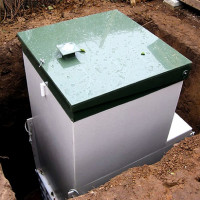 Installation of septic tank “Topas”: do-it-yourself installation + service rules
Installation of septic tank “Topas”: do-it-yourself installation + service rules 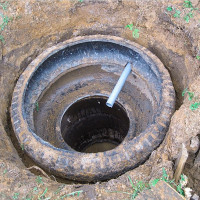 How to arrange a septic tank from tires with your own hands: step-by-step instructions
How to arrange a septic tank from tires with your own hands: step-by-step instructions 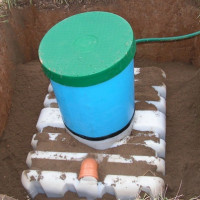 Overview of the septic tank for giving “Tank”: how it works, advantages and disadvantages of the system
Overview of the septic tank for giving “Tank”: how it works, advantages and disadvantages of the system 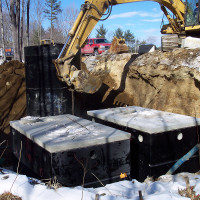 Installing a septic tank in winter: step-by-step instructions and analysis of possible errors
Installing a septic tank in winter: step-by-step instructions and analysis of possible errors 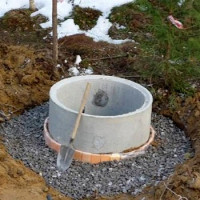 How to make a septic tank out of rings with your own hands: schemes and options + step-by-step instructions
How to make a septic tank out of rings with your own hands: schemes and options + step-by-step instructions 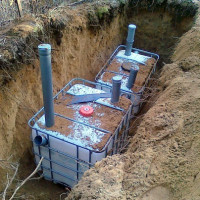 What capacity for a septic tank is better to choose + how to make it yourself
What capacity for a septic tank is better to choose + how to make it yourself  How much does it cost to connect gas to a private house: the price of organizing gas supply
How much does it cost to connect gas to a private house: the price of organizing gas supply  The best washing machines with dryer: model rating and customer tips
The best washing machines with dryer: model rating and customer tips  What is the color temperature of light and the nuances of choosing the temperature of the lamps to suit your needs
What is the color temperature of light and the nuances of choosing the temperature of the lamps to suit your needs  Replacement of a geyser in an apartment: replacement paperwork + basic norms and requirements
Replacement of a geyser in an apartment: replacement paperwork + basic norms and requirements
Such a septic tank up to 600 liters, we have in the country, we come there in spring, summer on weekends and vacations, we do not constantly live. I didn’t install it myself, my son-in-law was doing it, I was in the wings.
Intelligent solid construction, we immediately made an infiltrator for it. Our soil is sandy, so that it absorbs purified water for one or two.
At first I thought I wouldn’t miss it, I ordered everyone to pour water sparingly. Two seasons have passed, I have not opened it yet, and have not looked in, have not cleaned, maybe in the spring I will see what is done inside.